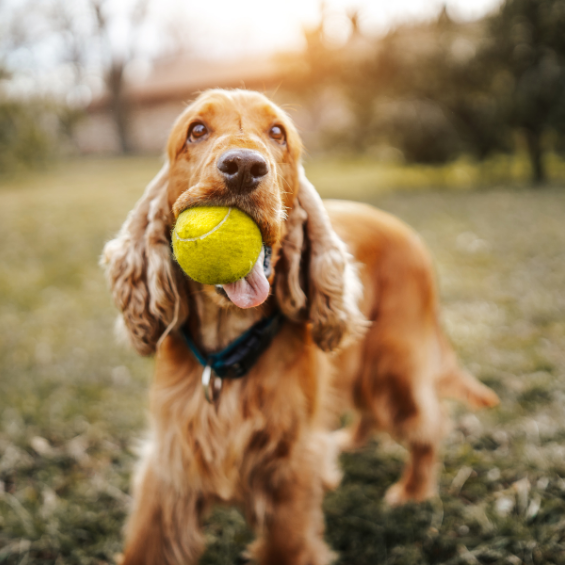
Positive Reinforcement for Pets
by Lauren Samet
19/10/2020
Positive reinforcement is a training method that focuses on rewarding wanted behaviours.
Providing a reward straight after a pet has performed a wanted behaviour allows them to associate what they have just done as being a good thing. This is in contrast to some other training methods where pets are punished for doing something then have to guess what their owner wants from them, which can be confusing and therefore slow down learning.
Besides being such an effective training method, there are other reasons to consider using it. For example, it can help build a positive, and therefore better, bond between animal and human. It can also help build a pet’s confidence and encourage them to think for themselves, which is an enriching and rewarding experience for both pet and owner.
Just like us, rewards look different to different animals; for some, it may be a fuss and attention, for some toys and games, and for others, it may be food or a treat.
These are NOT positive reinforcers:
- Shouting
- Shutting a dog outside
- Electronic collars
- Physically forcing a dog to sit
- Pulling a dog on a lead
Which Pets Can Positive Reinforcement Be Used For?
Positive reinforcement can be used to train all animals. Even fish have been taught to follow a laser point underwater when the behaviour is positively reinforced*. This is called “target training” and means that the fish can then be taught to swim under a bridge or even through a hoop by following a target.
Whether you own a cat, dog, rabbit, bird or bearded dragon, positive reinforcers can be used for reward-based training. The key is to find out what your pet finds rewarding as different individuals will have different preferences…
* Lasers should not be pointed directly at fish, as it can cause blindness. Read up on this before trying it at home and if children are taking part make sure they are supervised at all times.
Examples of Positive Reinforcers
Food
Food is possibly the most popular reward. Whether you use part of their dinner, or a special treat to encourage your pet, the key is for the reward to be of high value.
In an ideal world, treats should also be nutritionally valuable to your pet and not just “filler” in their daily food intake (remember the calories add up!).
For cats and dogs, the Vitapaws treat range could be a nutritionally valuable option. As the names suggest the DentaSupport treats are designed to support good oral hygiene in both cats and dogs, whilst the DigestiSupport treats are formulated with “friendly” bacteria and nutrients to promote gut flora health.
If you want to use food as a reward then the key is to never be too far away from your treat bag. When using positive reinforcement, you’ll want to deliver a timely treat when training is going well – leave it too late and you may be rewarding the wrong behaviour.
Tip: An old treat pouch or bum bag is useful to carry when you’re out and about with your pet and saves you finding bits of their food in the pockets of all your nice coats.
Fuss (and/or verbal praise)
Some pets live for affection, a neck scratch, a “good boy”, or your undivided attention. If your pet would rather receive a pat over a treat then make the most of this plentiful and free resource and give them the love they deserve! Additionally, for some pets, verbal praise is equally satisfying so don’t forget to tell them how great they are too!
Fun
Fun typically means your pet’s favourite toy or game but again, this might not be preferential for every pet compared to a fuss or a treat. Some may live for chasing a tennis ball, a tug of war, or a catnip mouse, and will do anything for said toy. Rewarding them with play is absolutely free and brings your pet some added exercise and enjoyment.
Did you know? Many of the UK’s sniffer dogs are trained to carry out their service roles via making it into one big game. Although referred to as working dogs many of them are motivated to find a specific scent by the knowledge (training) that they will get a reward at the end – that reward commonly being a toy!
Summary
Whichever method works best for you and your pet, you can be sure that using positive reinforcement can make their lives as fun and as full of encouragement as is possible so why not give it a try.
References
Blackwell, E. J., Twells, C., Seawright, A., & Casey, R. A. (2008). The relationship between training methods and the occurrence of behavior problems, as reported by owners, in a population of domestic dogs. Journal of Veterinary Behavior, 3(5), 207-217.
Dogs Trust (2019) Training with Rewards: Positive Reinforcement [online]. Available at: https://www.dogstrust.org.uk/help-advice/training/positive-reinforcement-training-with-rewards#:~:text=training%20with%20rewards%20is%20fun,dogs%20to%20think%20for%20themselves (accessed August 2020).
Laule, G. E. (2003). Positive reinforcement training and environmental enrichment: enhancing animal well-being. Journal of the American Veterinary Medical Association, 223(7), 969-973.
ALL PET NEWS





 Order before 12pm Mon-Fri for same day dispatch
Order before 12pm Mon-Fri for same day dispatch

